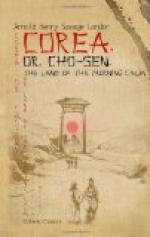The hills round the towns are simply covered with these little mounds of earth, and the greatest respect is shown by the natives for all places of sepulture. In course of time, many disappear by being washed away by the rain, but never by any chance are they interfered with by the people. The Coreans are extremely superstitious, and they are much afraid of the dead. Metempsychosis is not an uncommon trait of their minds, especially among the better classes; thus, for instance, the soul of the dead man is sometimes supposed to enter the body of a bird, in which case the relatives carefully build a semi-circular stone railing round the mound, so that the winged successor of the deceased may have whereon to perch.
The grave of one of the richer people is especially noteworthy. First, there is the mound in the centre as usual, but nearly twice the size of that which covers a poorer person. Then there is a stone railing a little way off; and between that and the mound stand in double rows, at the sides, rough images of human beings and horses carved in stone. The general rule is, in the case of a rich man, to have two men and two ponies on either side and a small column at the end; while in the case of a man not so much distinguished only a single horse and man respectively are placed on either side. The short column with a slab at the top is nearly always a feature. The stone images so placed are, as a rule, so badly carved that, unless one is told what they are meant to represent, it is really difficult to decide the point. The horses, especially, might easily be mistaken for sheep, dogs, or any other animal, the small stature of the native ponies being imitated in these images, to an exaggerated degree. As for the stone human-shaped images, these are usually made dressed in a long sort of gown and with the arms folded in front and the head covered by a curled up skull-cap, of the kind worn by Corean officials even at the present day, and formerly worn by all the high officials in China, whence probably the fashion has been imported.
A curious feature which I often noticed about the graves of people who had not been over well-off, and whose friends could not afford a large number of statues or figures of men and animals, was this:—If only one or two monuments were put up by the side of the mound, these invariably consisted of representations either of two horses or else of a horse and a ram, that is, if I am right in fixing the latter’s identity by the curled horns on the side of its head. If, on the other hand, the monuments were more than two in number, the others were, just as invariably, representations of human figures, the number of these being the same as that of beasts in the other case.




